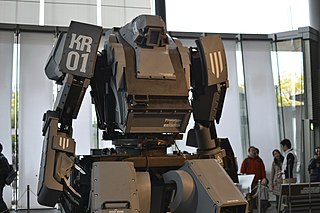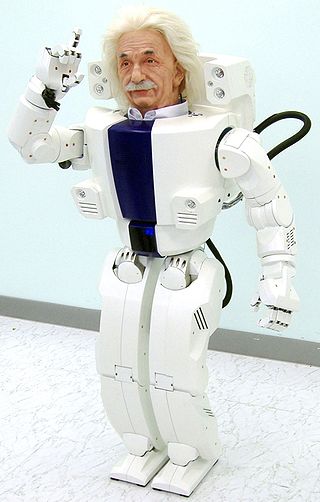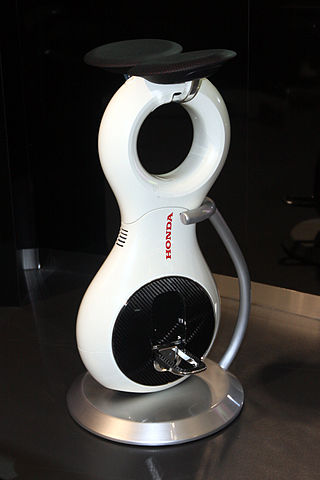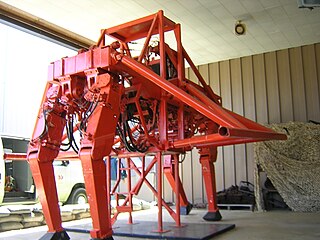
An android is a humanoid robot or other artificial being often made from a flesh-like material. Historically, androids were completely within the domain of science fiction and frequently seen in film and television, but advances in robot technology now allow the design of functional and realistic humanoid robots.

In science fiction, mecha or mechs are giant robots or machines typically depicted as piloted and as humanoid walking vehicles. The term was first used in Japanese after shortening the English loanword 'mechanism' or 'mechanical', but the meaning in Japanese is more inclusive, and 'robot' or 'giant robot' is the narrower term.

A humanoid robot is a robot resembling the human body in shape. The design may be for functional purposes, such as interacting with human tools and environments, for experimental purposes, such as the study of bipedal locomotion, or for other purposes. In general, humanoid robots have a torso, a head, two arms, and two legs, though some humanoid robots may replicate only part of the body, for example, from the waist up. Some humanoid robots also have heads designed to replicate human facial features such as eyes and mouths. Androids are humanoid robots built to aesthetically resemble humans.

ASIMO is a humanoid robot created by Honda in 2000. It is displayed in the Miraikan museum in Tokyo, Japan. On 8 July 2018, Honda posted the last update of Asimo on their official page stating that it would be ceasing all development and production of Asimo robots in order to focus on more practical applications using the technology developed through Asimo's lifespan. It made its last active appearance in March 2022, over 20 years after its first, as Honda announced that they are retiring the robot to concentrate on remote-controlled, avatar-style, robotic technology.

HUBO is a walking humanoid robot, head mounted on a life-size walking bipedal frame, developed by the Korea Advanced Institute of Science and Technology (KAIST) and released on January 6, 2005. According to Hubo's creator Prof Jun-Ho Oh and his Plenary Session at ICRA 2012 entitled Development Outline of the Humanoid Robot: HUBO II the name Hubo is simply a name, not an abbreviation.
The E series was a collection of successive humanoid robots created by the Honda Motor Company between the years of 1986 and 1993. These robots were only experimental, but later evolved into the Honda P series, with Honda eventually amassing the knowledge and experience necessary to create Honda's advanced humanoid robot: ASIMO. The fact that Honda had been developing the robots was kept secret from the public until the announcement of the Honda P2 in 1996.
Passive dynamics refers to the dynamical behavior of actuators, robots, or organisms when not drawing energy from a supply. Depending on the application, considering or altering the passive dynamics of a powered system can have drastic effects on performance, particularly energy economy, stability, and task bandwidth. Devices using no power source are considered "passive", and their behavior is fully described by their passive dynamics.
The zero moment point is a concept related to the dynamics and control of legged locomotion, e.g., for humanoid or quadrupedal robots. It specifies the point with respect to which reaction forces at the contacts between the feet and the ground do not produce any moment in the horizontal direction, i.e., the point where the sum of horizontal inertia and gravity forces is zero. The concept assumes the contact area is planar and has sufficiently high friction to keep the feet from sliding.
SIGMO is a humanoid robot designed to demonstrate the applications of passive dynamics technologies.
Robot software is the set of coded commands or instructions that tell a mechanical device and electronic system, known together as a robot, what tasks to perform. Robot software is used to perform autonomous tasks. Many software systems and frameworks have been proposed to make programming robots easier.

In Japan, popular robots include humanoid entertainment robots, androids, animal robots, social robots, guard robots, and many more. Each type has a variety of characteristics.

Legged robots are a type of mobile robot which use articulated limbs, such as leg mechanisms, to provide locomotion. They are more versatile than wheeled robots and can traverse many different terrains, though these advantages require increased complexity and power consumption. Legged robots often imitate legged animals, such as humans or insects, in an example of biomimicry.
The Humanoid Robotics Project (HRP) is a project for development of general domestic helper robots, sponsored by Japan's Ministry of Economy, Trade and Industry (METI) and New Energy and Industrial Technology Development Organization (NEDO), spearheaded by Kawada Industries and supported by the National Institute of Advanced Industrial Science and Technology (AIST) and Kawasaki Heavy Industries, Inc. The HRP series also goes by the name Promet. The HRP should not be confused with the HOAP series, which is manufactured by Fujitsu.

The history of robots has its origins in the ancient world. During the industrial revolution, humans developed the structural engineering capability to control electricity so that machines could be powered with small motors. In the early 20th century, the notion of a humanoid machine was developed.

The HRP-4C, nicknamed Miim, is a feminine-looking humanoid robot created by the National Institute of Advanced Industrial Science and Technology (AIST), a Japanese research facility.
Honda Advanced Technology is part of Honda's long-standing research and development program focused on building new models for their automotive products and automotive-related technologies, with many of the advances pertaining to engine technology. Honda's research has led to practical solutions ranging from fuel-efficient vehicles and engines, to more sophisticated applications such as the humanoid robot, ASIMO, and the Honda HA-420 Honda-jet, a six-passenger business jet.

The Honda U3-X is an experimental self-balancing one-wheeled personal transporter shown in 2009.
Surena is a series of Iranian humanoid robots, named after the Parthian General Surena. The Institute of Electrical and Electronics Engineers (IEEE) has placed the Surena among the prominent robots in the world after analyzing its performance.
Atlas is a bipedal humanoid robot primarily developed by the American robotics company Boston Dynamics with funding and oversight from the U.S. Defense Advanced Research Projects Agency (DARPA). The robot was initially designed for a variety of search and rescue tasks, and was unveiled to the public on July 11, 2013.

A walking vehicle is a vehicle that moves on legs rather than wheels or tracks. Walking vehicles have been constructed with anywhere from one to more than eight legs. There are many designs for the leg mechanisms of walking machines that provide foot trajectories with different properties.
















